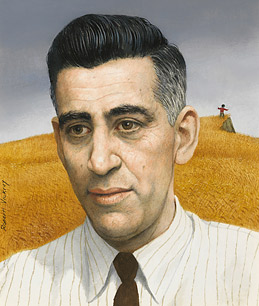
It wouldn’t be true to say that Holden Caulfield, the disaffected loner in The Catcher in the Rye, was always a stand-in for his creator, the disaffected loner J.D. Salinger. But there are times when Caulfield speaks that you just know it’s Salinger talking. Like when the teenager imagines running off to Vermont and pretending to be a deaf-mute. “Then I’d be through with having conversations for the rest of my life,” he vows, “and they’d leave me alone.” No such luck. Even after Salinger retreated to his own Fortress of Solitude in rural Cornish, N.H., the world kept trying to beat a path to his door. The enormous success of The Catcher in the Rye upon its publication in 1951 — an experience that Salinger said he found “professionally and personally demoralizing” — made its author irresistible to his all-too-devoted readers. To put it mildly, Salinger is a biographer’s nightmare. He refused interviews, banned his photo from his book jackets, cut off anyone who spoke about him to journalists and implored friends to destroy his letters. Some missives still made their way into various archives, but when the writer Ian Hamilton embarked on a biography in the 1980s, Salinger successfully sued to stop him from quoting from them. This, after all, was a man who once claimed that the very act of publishing was a “terrible invasion of my privacy.” At some point Salinger decided that his work wasn’t a conversation with his readers but with his characters. No one from outside their charmed circle need apply. But barely a year after Salinger’s death at age 91, a new biography is here. J.D. Salinger: A Life is by Kenneth Slawenski, who runs a website, DeadCaulfields.com devoted to all things Salinger. Slawenski’s prose is serviceable at best, and he has a weakness for awkward formulations. But he’s an energetic researcher, at least with respect to Salinger’s life through 1965, the year he published his final story. He doesn’t solve the puzzle that was Salinger — could anyone? — but he finds some important pieces. For one thing, Slawenski has established that Salinger’s mother was not, as often described, Irish Catholic but of German descent, though still a gentile who converted to Judaism when she married. Salinger’s father Sol, the son of Russian Jewish immigrants, was a meat and cheese importer. Their boy Jerome David was born in New York City on Jan. 1, 1919. By the time he turned 13, his father was prosperous enough to move the family to an apartment on Park Avenue and enroll his underachieving son at a Manhattan private school. Next came a military academy that would be the model for the den of “phonies” that Caulfield runs away from in Catcher. The Apprentice Writer Salinger would put in only three semesters at college, with a year in between in Europe partly to learn the ham business in Poland. Slawenski tells us that to mark his brief stay in the city of Bydgoszcz, there are plans to erect a statue of Salinger standing in a patch of living rye. It’s safe to say he wouldn’t have approved. See the top 10 fiction books of 2010.